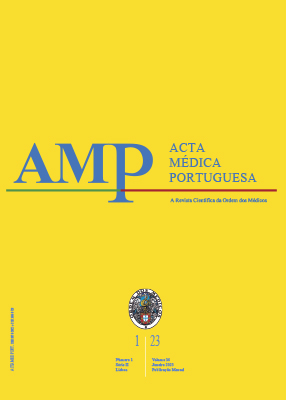An Uncommon Presentation of Pheochromocytoma in Neurofibromatosis Type 1 and the Importance of Long-Term Follow-Up
DOI:
https://doi.org/10.20344/amp.16604Keywords:
Neurofibromatosis 1, PheochromocytomaAbstract
Neurofibromatosis type 1 (NFT1) is a disease caused by mutations in the tumor suppressor gene NF1. It is associated with a higher incidence of chromaffin cell tumors which are usually adrenal, unilateral and benign. The presence of these tumors during pregnancy is extremely rare and frequently associated with fatal outcomes. We report the case of a female patient with NFT1, who presented with paroxysmal spells of headache, palpitations, dizziness and pre-cordial discomfort, starting immediately after the delivery of her third child. Diagnostic work-up came to reveal a bilateral pheochromocytoma and the patient underwent bilateral adrenalectomy. Over 12 years after the initial surgery, metastatic disease was diagnosed, and a reintervention was performed. This is a rare presentation of bilateral malignant pheochromocytoma in a patient with NFT1, with postpartum occurrence of the first symptoms. This text focuses the important details and challenges found at each stage of diagnosis and follow-up.Downloads
References
Ferner RE, Huson SM, Thomas N, Moss C, Willshaw H, Evans DG, et al. Guidelines for the diagnosis and management of individuals with neurofibromatosis 1. J Med Genet. 2007;44:81–8. DOI: https://doi.org/10.1136/jmg.2006.045906
Zografos GN, Vasiliadis GK, Zagouri F, Aggeli C, Korkolis D, Vogiaki S, et al. Pheochromocytoma associated with neurofibromatosis type 1: concepts and current trends. World J Surg Oncol. 2010;8:14. DOI: https://doi.org/10.1186/1477-7819-8-14
Lenders JW, Duh QY, Eisenhofer G, Gimenez-Roqueplo AP, Grebe SK, Murad MH, et al. Pheochromocytoma and paraganglioma: an endocrine society clinical practice guideline. J Clin Endocrinol Metab. 2014;99:1915–42. DOI: https://doi.org/10.1210/jc.2014-1498
Erlic Z, Neumann HP. Familial pheochromocytoma. Horm Athens Greece. 2009;8:29–38. DOI: https://doi.org/10.14310/horm.2002.1219
Walther MM, Herring J, Enquist E, Keiser HR, Linehan WM. von Recklinghausen’s disease and pheochromocytomas. J Urol. 1999;162:1582–6. DOI: https://doi.org/10.1016/S0022-5347(05)68171-2
Gruber LM, Erickson D, Babovic-Vuksanovic D, Thompson GB, Young WF, Bancos I. Pheochromocytoma and paraganglioma in patients with neurofibromatosis type 1. Clin Endocrinol. 2017;86:141–9. DOI: https://doi.org/10.1111/cen.13163
Remón-Ruiz P, Aliaga-Verdugo A, Guerrero-Vázquez R. Pheochromocytoma in neurofibromatosis type 1 during pregnancy. Gynecol Endocrinol Off J Int Soc Gynecol Endocrinol. 2017;33:93–5. DOI: https://doi.org/10.1080/09513590.2016.1254181
Neumann HP, Young WF, Eng C. Pheochromocytoma and paraganglioma. N Engl J Med. 2019;381:552–65. DOI: https://doi.org/10.1056/NEJMra1806651
Yohay K. Neurofibromatosis type 1 and associated malignancies. Curr Neurol Neurosci Rep. 2009;9:247–53. DOI: https://doi.org/10.1007/s11910-009-0036-3
Képénékian L, Mognetti T, Lifante JC, Giraudet AL, Houzard C, Pinson S, et al. Interest of systematic screening of pheochromocytoma in patients with neurofibromatosis type 1. Eur J Endocrinol. 2016;175:335–44. DOI: https://doi.org/10.1530/EJE-16-0233
Shinall MC, Solórzano CC. Pheochromocytoma in neurofibromatosis type 1: when should it be suspected? Endocr Pract Off J Am Coll Endocrinol Am Assoc Clin Endocrinol. 2014;20:792–6. DOI: https://doi.org/10.4158/EP13417.OR
Zinnamosca L, Petramala L, Cotesta D, Marinelli C, Schina M, Cianci R, et al. Neurofibromatosis type 1 (NF1) and pheochromocytoma: prevalence, clinical and cardiovascular aspects. Arch Dermatol Res. 2011;303:317–25. DOI: https://doi.org/10.1007/s00403-010-1090-z
Plouin PF, Amar L, Dekkers OM, Fassnacht M, Gimenez-Roqueplo AP, Lenders JW, et al. European Society of Endocrinology Clinical Practice Guideline for long-term follow-up of patients operated on for a phaeochromocytoma or a paraganglioma. Eur J Endocrinol. 2016;174:G1–10. DOI: https://doi.org/10.1530/EJE-16-0033
Butz JJ, Yan Q, McKenzie TJ, Weingarten TN, Cavalcante AN, Bancos I, et al. Perioperative outcomes of syndromic paraganglioma and pheochromocytoma resection in patients with von Hippel-Lindau disease, multiple endocrine neoplasia type 2, or neurofibromatosis type 1. Surgery. 2017;162:1259–69. DOI: https://doi.org/10.1016/j.surg.2017.08.002
Downloads
Published
How to Cite
Issue
Section
License
Copyright (c) 2022 Acta Médica Portuguesa

This work is licensed under a Creative Commons Attribution-NonCommercial 4.0 International License.
All the articles published in the AMP are open access and comply with the requirements of funding agencies or academic institutions. The AMP is governed by the terms of the Creative Commons ‘Attribution – Non-Commercial Use - (CC-BY-NC)’ license, regarding the use by third parties.
It is the author’s responsibility to obtain approval for the reproduction of figures, tables, etc. from other publications.
Upon acceptance of an article for publication, the authors will be asked to complete the ICMJE “Copyright Liability and Copyright Sharing Statement “(http://www.actamedicaportuguesa.com/info/AMP-NormasPublicacao.pdf) and the “Declaration of Potential Conflicts of Interest” (http:// www.icmje.org/conflicts-of-interest). An e-mail will be sent to the corresponding author to acknowledge receipt of the manuscript.
After publication, the authors are authorised to make their articles available in repositories of their institutions of origin, as long as they always mention where they were published and according to the Creative Commons license.









